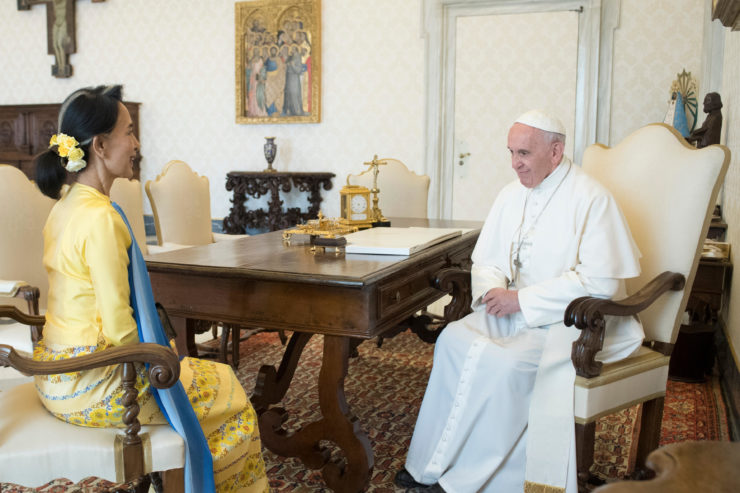VATICAN CITY, AUGUST 24, 2017 (Zenit.org).- Pope Francis could visit Burma (Myanmar) and Bangladesh at the end of the month of November 2017. Persistent sources mention this trip, which has not been confirmed or denied by the Holy See Press Office.
According to the English “Union of Catholic Asia News (UCANews), the Pope should visit Burma beginning on November 27, then Bangladesh where he should arrive on November 30 for a three-day stay.
According to the same source, these days a Vatican delegation is in Rangoon, the capital of Burma, to arrange details of the trip with the country’s Episcopal Conference. Cardinal Charles Bo, Archbishop of Rangoon – created Cardinal by Pope Francis in 2015 –, as well as the local Bishops, met with the military chief Min Aung Hlaing to discuss “the organization of Pope Francis’ visit and prospects of peace for the country.”
The Pontiff would celebrate two Masses, at Naypyidaw and at Rangoon. He should also meet with the President of Myanmar Htin Kyaw and the Counselor of State and Minister of Foreign Affairs, Aung San Suu Kyi. It would be the first visit of a Pope to the country.
In fact, Pope Francis was invited by President Htin Kyaw – a democrat close to Aung San Suu Kyi, President since March 30, 2016 – and by the Bishops, on the occasion of the 500 years of the arrival of Catholicism in Burma (2014).
The Vatican delegates should then go to Dacca, in Bangladesh, where the Pope could ordain 16 priests and meet with numerous political leaders and representatives of other religions. UCANews quote a priest of the delegation who specified that the trip should be announced officially at the end of the month of August.
The Pope’s Pleas for the Rohingyas
The trip to Myanmar would take place six months after the establishment of diplomatic relations between the Burmese Republic and the Holy See, last May 4, during Aung San Suu Kyi’s second visit to the Vatican, and the recent appointment, last August 12, of the Apostolic Delegate, Monsignor Paul Tschang In-Nam, as first Nuncio in the country.
The trip would be marked especially by Pope Francis repeated appeals in favor of the Burmese Muslim minority of the Rohingyas, persecuted in their country and rejected everywhere. During the General Audience last February 8, the Pope was saddened. They are “good people, peaceful people. They are not Christians, they are good, they are our brothers and sisters,” he said.
In his homily on May 19, 2015 At Saint Martha’s in the Vatican, he reacted after the arrival of thousands of migrants abandoned by passers-by on the coasts of Indonesia, Thailand and Malaysia. “We think today of those poor Rohingyas of Burma. On leaving their country to flee from persecutions, they didn’t know what would happen to them. And it’s now months that they are on a boat . . . They arrived in a town where they are given water, food and were told to “go away!” . . . And that’s happening today.”
In August of the same year, the Pope said before members of the Young People’s Eucharistic Movement: “Let’s think of our Rohingya brothers: they are chased from one country to another, and from one side of the sea to another . . . When they arrive in a port or on a beach, they are given some water and something to eat and then chased back to the sea. It’s an unresolved conflict, and it’s a war, it’s called violence, it’s called to kill.”
According to data of the Arakan Project, a humanitarian organization defending the rights of the Rohingyas, since 2010 some 100,000 members of this minority have fled Burma by sea. Since 2012 the violence between radical Buddhists and Rohingyas has caused more than 200 deaths and 140,000 displaced.
A Muslim Majority
The Pope’s visit to Bangladesh should take place 31 years after that of Pope John Paul II in November of 1986. Islam is the State religion there: around 90% of the population is Muslim, 8% is Hindu, and the remaining 2% groups the other religions. It’s estimated that Christians represent – all the Confessions mixed together – about 1% of the population, of which half are Catholics.
Cardinal Jean Louis Tauran, President of the Pontifical Council for Inter-Religious Dialogue, who went there in 2011, says that Bangladesh is an “example” of coexistence between different religious beliefs, “a unique model of community and of religious harmony.”
On November 19, 2016, Pope Francis created the first Cardinal in the history of the country, Monsignor Patrick D’Rozario, Archbishop of Dacca.
Translation by Virginia M. Forrester

Aung San Suu Kyi, May 4, 2017 © L'Osservatore Romano
Burma and Bangladesh: The Pope’s Possible Trip in November 2017
A Vatican Delegation Is Visiting the Two Countries


